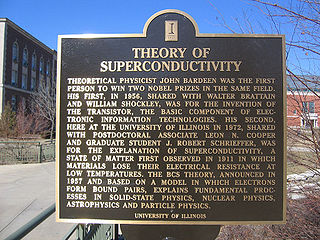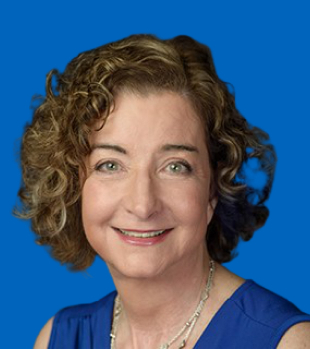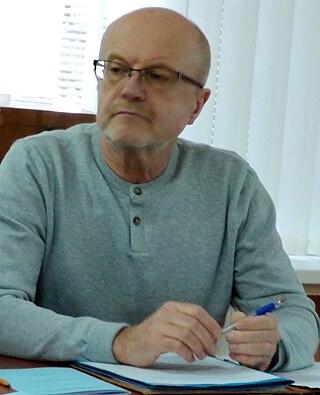
In physics, theBardeen–Cooper–Schrieffer (BCS) theory is the first microscopic theory of superconductivity since Heike Kamerlingh Onnes's 1911 discovery. The theory describes superconductivity as a microscopic effect caused by a condensation of Cooper pairs. The theory is also used in nuclear physics to describe the pairing interaction between nucleons in an atomic nucleus.

Superconductivity is a set of physical properties observed in certain materials where electrical resistance vanishes and magnetic fields are expelled from the material. Any material exhibiting these properties is a superconductor. Unlike an ordinary metallic conductor, whose resistance decreases gradually as its temperature is lowered, even down to near absolute zero, a superconductor has a characteristic critical temperature below which the resistance drops abruptly to zero. An electric current through a loop of superconducting wire can persist indefinitely with no power source.

High-temperature superconductors are defined as materials with critical temperature above 77 K, the boiling point of liquid nitrogen. They are only "high-temperature" relative to previously known superconductors, which function at even colder temperatures, close to absolute zero. The "high temperatures" are still far below ambient, and therefore require cooling. The first break through of high-temperature superconductor was discovered in 1986 by IBM researchers Georg Bednorz and K. Alex Müller. Although the critical temperature is around 35.1 K, this new type of superconductor was readily modified by Ching-Wu Chu to make the first high-temperature superconductor with critical temperature 93 K. Bednorz and Müller were awarded the Nobel Prize in Physics in 1987 "for their important break-through in the discovery of superconductivity in ceramic materials". Most high-Tc materials are type-II superconductors.
A room-temperature superconductor is a hypothetical material capable of displaying superconductivity at temperatures above 0 °C, which are commonly encountered in everyday settings. As of 2023, the material with the highest accepted superconducting temperature was highly pressurized lanthanum decahydride, whose transition temperature is approximately 250 K (−23 °C) at 200 GPa.

Superconductivity is the phenomenon of certain materials exhibiting zero electrical resistance and the expulsion of magnetic fields below a characteristic temperature. The history of superconductivity began with Dutch physicist Heike Kamerlingh Onnes's discovery of superconductivity in mercury in 1911. Since then, many other superconducting materials have been discovered and the theory of superconductivity has been developed. These subjects remain active areas of study in the field of condensed matter physics.

Indium nitride is a small bandgap semiconductor material which has potential application in solar cells and high speed electronics.

The A15 phases (also known as β-W or Cr3Si structure types) are series of intermetallic compounds with the chemical formula A3B (where A is a transition metal and B can be any element) and a specific structure. The A15 phase is also one of the members in the Frank–Kasper phases family. Many of these compounds have superconductivity at around 20 K (−253 °C; −424 °F), which is comparatively high, and remain superconductive in magnetic fields of tens of teslas (hundreds of kilogauss). This kind of superconductivity (Type-II superconductivity) is an important area of study as it has several practical applications.

In condensed matter physics, a pseudogap describes a state where the Fermi surface of a material possesses a partial energy gap, for example, a band structure state where the Fermi surface is gapped only at certain points.

In superconductivity, a type-II superconductor is a superconductor that exhibits an intermediate phase of mixed ordinary and superconducting properties at intermediate temperature and fields above the superconducting phases. It also features the formation of magnetic field vortices with an applied external magnetic field. This occurs above a certain critical field strength Hc1. The vortex density increases with increasing field strength. At a higher critical field Hc2, superconductivity is destroyed. Type-II superconductors do not exhibit a complete Meissner effect.

Andreev reflection (AR), named after the Russian physicist Alexander F. Andreev, is a type of particle scattering which occurs at interfaces between a superconductor (S) and a normal state material (N). It is a charge-transfer process by which normal current in N is converted to supercurrent in S. Each Andreev reflection transfers a charge 2e across the interface, avoiding the forbidden single-particle transmission within the superconducting energy gap.

Proximity effect or Holm–Meissner effect is a term used in the field of superconductivity to describe phenomena that occur when a superconductor (S) is placed in contact with a "normal" (N) non-superconductor. Typically the critical temperature of the superconductor is suppressed and signs of weak superconductivity are observed in the normal material over mesoscopic distances. The proximity effect is known since the pioneering work by R. Holm and W. Meissner. They have observed zero resistance in SNS pressed contacts, in which two superconducting metals are separated by a thin film of a non-superconducting metal. The discovery of the supercurrent in SNS contacts is sometimes mistakenly attributed to Brian Josephson's 1962 work, yet the effect was known long before his publication and was understood as the proximity effect.

Superconducting wires are electrical wires made of superconductive material. When cooled below their transition temperatures, they have zero electrical resistance. Most commonly, conventional superconductors such as niobium–titanium are used, but high-temperature superconductors such as YBCO are entering the market.
Arthur Foster Hebard is Distinguished Professor of Physics at University of Florida in Gainesville, Florida. He is particularly noted for leading the discovery of superconductivity in Buckminsterfullerene in 1991.

Laura H. Greene is the Marie Krafft Professor of Physics at Florida State University and chief scientist at the National High Magnetic Field Laboratory. She was previously a professor of physics at the University of Illinois at Urbana-Champaign. In September 2021, she was appointed to the President's Council of Advisors on Science and Technology (PCAST).
Aharon Kapitulnik is an Israeli-American experimental condensed matter physicist working at Stanford University. He is known primarily for his work on strongly correlated electron systems, low dimensional electronic systems, unconventional superconductors, topological superconductors, superconductivity and magnetism, transport in bad metals and precision measurements.
John Kenneth Hulm was a British-American physicist and engineer, known for the development of superconducting materials with applications to high-field superconducting magnets. In 1953 with George F. Hardy he discovered the first A-15 superconducting alloy.

Yurii Georgiyovych Naidyuk is a Ukrainian physicist, Director of the B.I. Verkin Institute for Low Temperature Physics and Engineering of the National Academy of Sciences of Ukraine. He is a corresponding member of the National Academy of Sciences of Ukraine (NASU). He has been awarded the State Prize of Ukraine in Science and Technology and the B. I. Verkin Prize of the National Academy of Sciences of Ukraine. He is the editor-in-chief of the academic journal Low Temperature Physics.
Yvan J. Bruynseraede is a condensed matter experimental physicist, known for his work on multilayers and superlattices, and his interests are thin films, nanostructures, novel materials, magnetism, and superconductivity. He is currently Professor Emeritus at the Catholic University of Leuven (KULeuven), and a member of the Quantum Solid-State Physics Laboratory.
Allen Marshall Goldman is an American experimental condensed matter physicist, known for his research on electronic transport properties of superconductors and for the eponymous Carlson-Goldman mode involving collective oscillations in superconductors.













